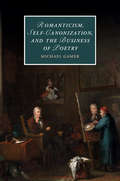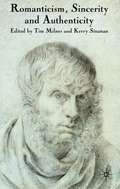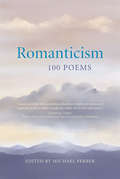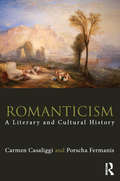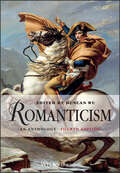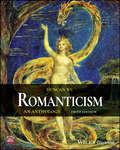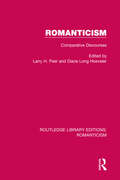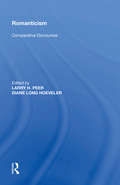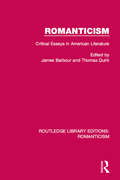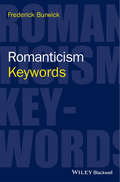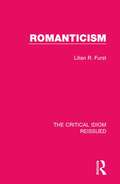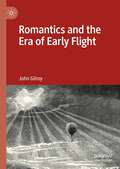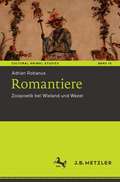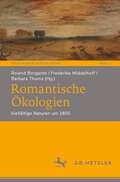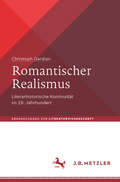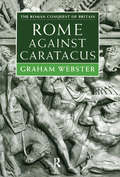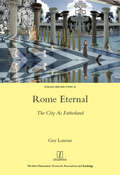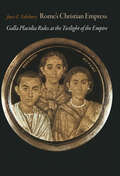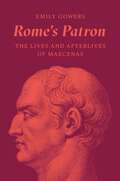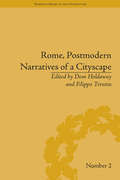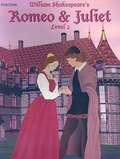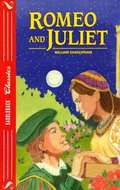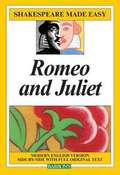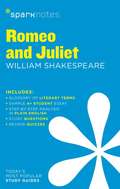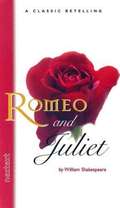- Table View
- List View
Romanticism, Self-Canonization, and the Business of Poetry (Cambridge Studies in Romanticism)
by Michael GamerThis is the first book to examine how Romantic writers transformed poetic collections to reach new audiences. In a series of case studies, Michael Gamer shows Romantic poets to be fundamentally social authors: working closely with booksellers, intimately involved in literary production, and resolutely concerned with current readers even as they presented themselves as disinterested artists writing for posterity. Exploding the myth of Romantic poets as naive, unworldly, or unconcerned with the practical aspects of literary production, this study shows them instead to be engaged with intellectual property, profit and loss, and the power of reprinting to reshape literary reputation. Gamer offers a fresh perspective on how we think about poetic revision, placing it between aesthetic and economic registers and foregrounding the centrality of poetic collections rather than individual poems to the construction of literary careers.
Romanticism, Sincerity and Authenticity
by Tim Milnes Kerry SinananThe categories of authenticity and sincerity, treated sceptically since the early twentieth century, remain indispensable for the study of Romantic literature and culture. This book, focusing on authors including Wordsworth, Macpherson and Austen, highlights their complexities, showing how they can become meaningful to current critical debates.
Romanticism: 100 Poems
by Michael Ferber'Romanticism', though a debated term, is broadly understood as a cultural movement which gripped the European imagination in the late eighteenth and early nineteenth centuries. Embodying a poetics of feeling intersecting with nature and the notion of the sublime, its experiential aesthetics were furthermore bound up with ideas of personal and political rebellion. Michael Ferber's lively anthology includes lesser-known verse from the best-known poets, as well as a few fine poems by little-known poets. Perfect for readers who would like to enjoy the many riches of arguably poetry's greatest era, or for those already familiar with the poets but who would welcome some happy surprises, this varied international selection includes verse translated from six languages, with several poems appearing in the original language alongside its translation. This engaging selection features concise, informative headnotes and a helpful introduction that charts a course to understanding the Romantic movement as a whole.
Romanticism: A Literary and Cultural History
by Carmen Casaliggi Porscha FermanisThe Romantic period coincided with revolutionary transformations of traditional political and human rights discourses, as well as witnessing rapid advances in technology and a primitivist return to nature. As a broad global movement, Romanticism strongly impacted on the literature and arts of the late eighteenth and early nineteenth centuries in ways that are still being debated and negotiated today. Examining the poetry, fiction, non-fiction, drama, and the arts of the period, this book considers: Important propositions and landmark ideas in the Romantic period; Key debates and critical approaches to Romantic studies; New and revisionary approaches to Romantic literature and art; The ways in which Romantic writing interacts with broader trends in history, politics, and aesthetics; European and Global Romanticism; The legacies of Romanticism in the twentieth and twenty-first centuries. Containing useful, reader-friendly features such as explanatory case studies, chapter summaries, and suggestions for further reading, this clear and engaging book is an invaluable resource for anyone who intends to study and research the complexity and diversity of the Romantic period, as well as the historical conditions which produced it.
Romanticism: An Anthology (Blackwell Anthologies #5)
by Duncan WuThis new edition of the groundbreaking Romanticism: An Anthology is the only book of its kind to contain complete texts of a wide range of Romantic works, including Blake's Songs of Innocence and of Experience, The Marriage of Heaven and Hell, and Urizen; Wordsworth and Coleridge's Lyrical Ballads (1798); Wordsworth's Two-Part Prelude; early and revised versions of Coleridge's 'The Eolian Harp', 'This Lime-Tree Bower my Prison', 'Frost at Midnight', and 'The Ancient Mariner'; Shelley's Prometheus Unbound, Epipsychidion and Adonais; Byron's Childe Harold's Pilgrimage Canto III and Don Juan Dedication and Cantos I and II; and Keats's Odes, the two Hyperions, Lamia, Isabella and The Eve of St Agnes. It also carries explanatory annotations and author headnotes. Updated to incorporate the latest scholarly findings, it remains the essential text on Romanticism. Don Juan Dedication and Cantos I and II; and Keats's Odes, the two Hyperions, Lamia, Isabella and The Eve of St Agnes. It also carries explanatory annotations and author headnotes. Updated to incorporate the latest scholarly findings, it remains the essential text on Romanticism. Includes all texts from the third edition, with the addition of Keats's Isabella and Shelley's Epipsychidion, as well as a selection of the poems of Walter Scott Includes a wider and deeper selection of texts by the Big Six male poets (Blake, Wordsworth, Coleridge, Keats, Byron and Shelley) than any competing volume Includes a generous range of texts by female Romantic poets All editorial materials, including annotations, author headnotes, and prefatory materials, have been revised for the new edition The only book to contain complete texts, edited for this volume from manuscript and early printed sources by Wu, along with explanatory annotations and author headnotes Contains everything teachers and students require for an in-depth survey of the principal writings to emerge from the British Romantic period The most widely-used teaching anthology in the field in the UK Companion website features a dynamic timeline detailing significant events of the romantic period and providing images, suggestions for further reading and useful links to other online resources: www.romanticismanthology.com
Romanticism: An Anthology (Blackwell Anthologies Ser. #5)
by Duncan WuThe essential work on Romanticism, revised and condensed for student convenience Standing as the essential work on Romanticism, Duncan Wu’s Romanticism: An Anthology has been appreciated by thousands of literature students and their teachers across the globe since its first appearance in 1994. This Fifth Edition has been revised to reduce the size of the book and the burden of carrying it around a university campus. It includes the six canonical authors: Blake, Wordsworth, Coleridge, Keats, Byron, and Shelley. The Fourth Edition of the anthology, with complete and uncut texts of a wealth of Romantic authors, is available to all readers of the Fifth Edition via online access. Authors are introduced successively by their dates of birth; works are placed in order of composition where known and, when not known, by date of publication. Except for works in dialect or in which archaic effects were deliberately sought, punctuation and orthography are normalized, pervasive initial capitals and italics removed, and contractions expanded except where they are of metrical significance. Texts are edited for this volume from both manuscript and early printed sources. Romanticism: An Anthology contains everything a teacher needs for full coverage of the canonical poets, with illustrations and a chronological timeline to provide readers with important historical context.
Romanticism: Comparative Discourses (Routledge Library Editions: Romanticism)
by Larry H. Peer and Diane Long HoevelerFirst published in 2006. Exploring how discourse is figured in the texts of key European Romantic authors such as Wackenroder, Coleridge, Byron and Hugo, this volume offers nuanced readings of the under-explored syntactic, semantic, and ideological structures of Romantic works. Rather than proposing a new theoretical position on the issue of what constitutes Romantic discourse studies, the editors have commissioned essays that seek to capture aspects of this discursive field, building on previous scholarship to offer fresh ways of seeing how Romantic discourse matrices work. The volume is organized into three sections: Language and Romantic Discourse Systems; Women Writers and Romantic Constructions of Power; and Varieties of Revisionist Discourse in Romanticism. This title aims to expand the readers understand of Romantic modes of argumentation, and will be of interest to students of literature.
Romanticism: Comparative Discourses (The\nineteenth Century Ser.)
by Diane Long HoevelerExploring how discourse is figured in the texts of key European Romantic authors such as Wackenroder, Coleridge, Byron, and Hugo, this volume offers nuanced readings of the under-explored syntactic, semantic, and ideological structures of Romantic works. Rather than proposing a new theoretical position on the issue of what constitutes Romantic discourse studies, the editors have commissioned essays that seek to capture aspects of this discursive field, building on previous scholarship to offer fresh ways of seeing how Romantic discourse matrices work. The volume is organized into three sections: Language and Romantic Discourse Systems; Women Writers and Romantic Constructions of Power; and Varieties of Revisionist Discourse in Romanticism. Each section features individual essays providing critical re-readings of nine Romantic texts and four Romantic topoi. Whether writing on Charlotte Smith's The Old Manor House or Anne Brontë's Agnes Grey, on rescue operas or criminal drama, the contributors, who include Marjean Purinton, Kari Lokke, Rodney Farnsworth, and Jeffrey Cass, expand our understanding of Romantic modes of argumentation.
Romanticism: Critical Essays in American Literature (Routledge Library Editions: Romanticism #2)
by JAMES BARBOUR AND THOMAS QUIRKFirst published in 1986. This outstanding collection of major essays by some of America’s finest literary scholars and critics provides students of American literature with a unique perspective of America’s Romantic literature. Some of these essays make connections between authors or define Romanticism in terms of one of the works; others address major issues during the period; others offer a framework for specific works; and, finally, some give interpretations for the reader. All of the essays offer distinctive voices that will engage students in this rich and memorable period of American literature.
Romanticism: Keywords (Keywords in Literature and Culture (KILC).)
by Frederick BurwickCompiles 70 of the key terms most frequently used or discussed by authors of the Romantic period – and most often deliberated by critics and literary historians of the era. Offers an indispensable resource for understanding the ideas and differing interpretations that shaped the Romantic period Includes keywords spanning Abolition and Allegory, through Madness and Monsters, to Vision and Vampires Features in-depth descriptions of each entry’s direct meaning and connotations in relation to its usage and thought in literary culture Provides deep insights into the political, social, and cultural climate of one of the most expressive periods of Western literary history Draws on the author’s extensive experience of teaching, lecturing, and writing on Romantic literature
Romanticism: Self-definition (The Critical Idiom Reissued #2)
by Lilian R. FurstFirst published in 1969, this work traces the evolution of Romanticism and in doing so, demonstrates its novelty as an imaginative and emotional perception of the world in contrast to the rationalistic approach which was dominant in the seventeenth century. It identifies the fundamental similarities between Romantic writing in England, France and Germany as well as their differences brought about by divergent literary and social backgrounds. The book is concluded by a review of the problems that arise from a simple definition of Romanticism.
Romantics and the Era of Early Flight
by John GilroyThis book explores the significance of flight to Romantic literature. Although the Romantic movement and the age of ballooning coincided, there has been a curious and long-time tendency to forget that flight was not impossible during this period. This study details the importance of this new technology to Romantic authors, primarily English Romantic poets. It combines accounts of the exploits and experiences of early balloonists with references to Romantic texts, using ballooning lore to illuminate a range of Romantic writings. The balloonists are seen as not just supplying these writers with a new code of metaphors, but as colleagues engaged in similarly imaginative enterprises. The book uncovers an ‘aerial imagination’ shared by a large number of writers in the Romantic period that has its origins in the balloon adventures of the 1780s and following two decades. It will appeal to scholars and students of Romantic cultural history, as well as those interested in Romantic poetry and the history of early aeronautics.
Romantiere: Zoopoetik bei Wieland und Wezel (Cultural Animal Studies #10)
by Adrian RobanusDiese literaturwissenschaftliche Studie befasst sich mit Konzeptionen des Tiers in der Spätaufklärung. In der Anthropologie des 18. Jahrhunderts sind Tiere wichtige Grenzfiguren. Das gilt sowohl für ‚das Tier‘ als abstrakte Kategorie als auch für konkrete Tiere – am prominentesten den Affen. Auch im politischen Denken der Aufklärung tauchen häufig tierliche Reflexionsfiguren auf, etwa Wölfe oder Löwen. Die Arbeit erforscht, wie zeitgenössische Romane von Wieland und Wezel aus diesen Tierfigurationen eine Zoopoetik entwickeln. Der spezifische ‚Gebrauch‘ der Romantiere in den untersuchten Texten macht die Funktion von Tierkonzeptionen für Anthropologie und Politik des 18. Jahrhunderts besser verstehbar.
Romantische Ökologien: Vielfältige Naturen um 1800 (Neue Romantikforschung #4)
by Roland Borgards Frederike Middelhoff Barbara ThumsDer Band widmet sich der Frage, wie sich europäische Romantiken im Zeitraum zwischen ca. 1790 und 1850 mit ökologischen Theoremen und umweltbezogenen Problembereichen auseinandersetzen. Die Aufsätze dieses interdisziplinären Sammelbandes untersuchen dabei insbesondere den spezifischen Beitrag, den die Künste bei der Ausgestaltung und Formierung eines modernen ökologischen Denkens leisten, das seit Ende des 18. Jahrhunderts Gestalt annimmt, in den 1860er Jahren mit Ernst Haeckels Definition der ‚Ökologie‘ terminologisch grundiert wird und bis heute unser Verständnis von ökologischen Zusammenhängen prägt. Der Band bereichert auf diese Weise die bereits lebendige Forschungslandschaft der Environmental Humanities im Allgemeinen, des Romantic Ecocriticism im Speziellen und fragt mit Blick auf die ‚Romantischen Ökologien‘ nicht nur nach der Diversität und den konfliktreichen Bruchlinien ökologischer Denkformen um 1800, sondern auch nach dem Stellenwert, dem Eigen- und möglicherweise Mehrwert des Ästhetischen sowie, damit verknüpft, nach der Rolle des Romantischen für die Entstehung, Reflexion und Transformation eines ökologischen Denkens.
Romantischer Realismus: Literarhistorische Kontinuität im 19. Jahrhundert (Abhandlungen zur Literaturwissenschaft)
by Christoph GardianRomantik und Realismus werden in der Literaturgeschichtsschreibung vorwiegend als Gegensätze beschrieben. Ihre Rekonstruktion als dichotome Epochen verstellt aber den Blick auf die Kontinuitäten zwischen den beiden großen Literaturbewegungen des 19. Jahrhunderts, auf ihre gemeinsamen Problemfelder und Strategien zur Problembewältigung. Denn weshalb beziehen sich Texte in der zweiten Hälfte des 19. Jahrhunderts permanent auf eine Literatur, die sie als ›Romantik‹ kennzeichnen und aus der Welt schaffen wollen? Weshalb bearbeiten Texte, die als ›realistische‹ positioniert werden, über einen Zeitraum von immerhin gut 50 Jahren Konzepte und Themenkomplexe, die erkennbar ihren Anfang in der von ihnen abgelehnten und als obsolet konzipierten Romantik nehmen? Weshalb lassen sie fortwährend romantische Figuren auftreten oder romantische Motive handlungsleitend ein? Ganz offenbar handelt es sich beim Romantischen, das der Realismus bestreitet, um einen unerledigten Problemkomplex. Ausgehend vondiesen Beobachtungen stellt sich das Verhältnis von romantischer und realistischer Literatur weniger als epochale Dichotomie, sondern vielmehr als konstitutives Wechselverhältnis dar – als komplementäre Konstellation vor einem gemeinsamen Problemhorizont. Romantische und realistische Literatur lassen sich als alternative und gleichwohl parallele Strategien im Umgang mit historischen Transformationsprozessen auffassen, die ungeachtet ihrer markierten Konkurrenz kaum jemals ungemischt zur Anwendung kommen. Romantische und realistische Tendenzen treten in wechselseitiger Abhängigkeit auf. Dabei geht es sowohl den programmatisch romantisierenden als auch den programmatisch realistischen Texten um nicht weniger als die Gestaltung gesellschaftlicher Realität. Auf der Grundlage einer anderen Begründungsgeschichte der deutschsprachigen Literatur im 19. Jahrhundert lassen sich Beschreibungsmodelle für kulturelle Identifikations- und Transformationsprozesse gewinnen. Die untersuchten literarischen Texte formulieren ebenso Konzepte für den Umgang mit kulturellem Wandel wie sie Konstellationen kulturellen Wandels als Positionskämpfe zwischen romantischen und realistischen Akteuren konfigurieren.
Rome Against Caratacus: The Roman Campaigns in Britain AD 48-58
by Graham WebsterThe Roman Conquest of Britain in AD 43 was one of the most important turning points in the history of the British Isles. It left a legacy still discernible today in the form of archaeological remain, road networks, land divisions and even language.In his much-acclaimed trilogy, now up-dated and revised, Dr Webster builds up a fascinating and lively picture of Britain in the first century AD and discussed in detail the various types of evidence and the theories based upon it.Caratacus' last stand against the Romans has a central place in the folklore of the Welsh Marches, where many a hill is claimed to be the site of the famous battle. But, as Graham Webster shows, this epic encounter was not only real history but also part of an intricate ten-year series of campaigns conducted after the initial conquest of Britain.By interpreting the ancient historical accounts and piecing together the masses of archaeological evidence, Dr Webster has brilliantly reconstructed this central period of the Claudian Conquest of Britain and its immediate aftermath.
Rome Eternal: The City as Fatherland
by Guy LanoueWhat does 'Roman' mean? How does the mythical city touch people's identities, values and attitudes? In the long-established and official imaginary of the West, Rome is the citta dell'arte, the city of faith, an heirloom city inspired by the traces of ancient Empire, by the brooding aura of the Church, by Hollywood fairy-tale romance, and by the spicy tang of veiled decadence. But what of its contemporary residents? Are they now merely guides and waiters servicing throngs of tourists indifferent to the city's contemporary charms? Guy Lanoue, a former resident of Rome, explores how Romans live the modern myth of Rome Eternal. Since the 19th century, it has defined an important community, the fatherland, a home-spun society where the rules of everyday life become 'tradition': ways of eating, dressing, making and keeping friends and acquaintances, 'proper' ways of speaking and a hard to define but nonetheless tangible air of composure. Guy Lanoue is a Professor of Anthropology at the Universite de Montreal.
Rome's Christian Empress: Galla Placidia Rules at the Twilight of the Empire
by Joyce E. SalisburyThe page-turning account of Galla Placidia, a remarkable ruler at the twilight of the Roman Empire.In Rome’s Christian Empress, Joyce E. Salisbury brings the captivating story of Rome’s Christian empress to life. The daughter of Roman emperor Theodosius I, Galla Placidia lived at the center of imperial Roman power during the first half of the fifth century. Taken hostage after the fall of Rome to the Goths, she was married to the king and, upon his death, to a Roman general. The rare woman who traveled throughout Italy, Gaul, and Spain, she eventually returned to Rome, where her young son was crowned as the emperor of the western Roman provinces. Placidia served as his regent, ruling the Roman Empire and the provinces for twenty years.Salisbury restores this influential, too-often forgotten woman to the center stage of this crucial period. Describing Galla Placidia’s life from childhood to death while detailing the political and military developments that influenced her—and that she influenced in turn—the book relies on religious and political sources to weave together a narrative that combines social, cultural, political, and theological history. The Roman world changed dramatically during Placidia’s rule: the Empire became Christian, barbarian tribes settled throughout the West, and Rome began its unmistakable decline. But during her long reign, Placidia wielded formidable power. She fended off violent invaders and usurpers who challenged her Theodosian dynasty; presided over the dawn of the Catholic Church as theological controversies split the faithful and church practices and holidays were established; and spent fortunes building churches and mosaics that incorporated prominent images of herself and her family. Compulsively readable, Rome’s Christian Empress is the first full-length work to give this fascinating and complex ruler her due.
Rome's Patron: The Lives and Afterlives of Maecenas
by Emily GowersThe story of Maecenas and his role in the evolution and continuing legacy of ancient Roman poetry and cultureAn unelected statesman with exceptional powers, a patron of the arts and a luxury-loving friend of the emperor Augustus: Maecenas was one of the most prominent and distinctive personalities of ancient Rome. Yet the traces he left behind are unreliable and tantalizingly scarce. Rather than attempting a conventional biography, Emily Gowers shows in Rome’s Patron that it is possible to tell a different story, one about Maecenas’s influence, his changing identities and the many narratives attached to him across two millennia.Rome’s Patron explores Maecenas’s appearances in the central works of Augustan poetry written in his name—Virgil’s Georgics, Horace’s Odes and Propertius’s elegies—and in later works of Latin literature that reassess his influence. For the Roman poets he supported, Maecenas was a mascot of cultural flexibility and innovation, a pioneer of gender fluidity and a bearer of imperial demands who could be exposed as a secret sympathizer with their own values. For those excluded from his circle, he represented either favouritism and indulgence or the lost ideal of a patron in perfect collaboration with the authors he championed.As Gowers shows, Maecenas had and continues to have a unique cachet—in the fantasies that still surround the gardens, buildings and objects so tenuously associated with him; in literature, from Ariosto and Ben Johnson to Phillis Wheatley and W. B. Yeats; and in philanthropy, where his name has been surprisingly adaptable to more democratic forms of patronage.
Rome, Postmodern Narratives of a Cityscape (Warwick Series in the Humanities #2)
by Dom HoldawayUntil the mid-twentieth century the Western imagination seemed intent on viewing Rome purely in terms of its classical past or as a stop on the Grand Tour. This collection of essays looks at Rome from a postmodern perspective, including analysis of the city's 'unmappability', its fragmented narratives and its iconic status in literature and film.
Romeo & Juliet (Easy Reading Old World Literature, Level #2)
by William Shakespeare Ed TeelingThis novel has been adapted into 10 short reading chapters.Abridged with excersice activities built in along with answer keys.
Romeo And Juliet (Shakespeare Classics)
by William ShakespeareNow you can reach today's adolescents with the universal messages of great literature. Presented in traditional play script format, each title features simplified language, easy-to-read type size, and strict adherence to the tone and integrity of the original play.
Romeo And Juliet (Shakespeare Made Easy)
by William Shakespeare Alan DurbandHere are the books that help teach Shakespeare plays without the teacher constantly needing to explain and define Elizabethan terms, slang, and other ways of expression that are different from our own. Each play is presented with Shakespeare's original lines on each left-hand page, and a modern, easy-to-understand "translation" on the facing right-hand page. All dramas are complete, with every original Shakespearian line, and a full-length modern rendition of the text.
Romeo And Juliet (Sparknotes Literature Guide)
by William ShakespeareTHE MOST INFLUENTIAL WRITER IN ALL OF English literature, William Shakespeare was born in 1564 to a successful middle-class glove-maker in Stratford-upon-Avon, England. Shakespeare attended grammar school, but his formal education proceeded no further. In 1582 he married an older woman, Anne Hathaway, and had three children with her. Around 1590 he left his family behind and traveled to London to work as an actor and playwright. Public and critical success quickly followed, and Shakespeare eventually became the most popular playwright in England and part-owner of the Globe Theater. His career bridged the reigns of Elizabeth I (ruled 1558-1603) and James I (ruled 1603-1625), and he was a favorite of both monarchs. Indeed, James granted Shakespeare's company the greatest possible compliment by bestowing upon its members the title of King's Men. Wealthy and renowned, Shakespeare retired to Stratford and died in 1616 at the age of fifty-two. At the time of Shakespeare's death, literary luminaries such as Ben Jonson hailed his works as timeless.
Romeo And Juliet: A Classic Retelling (Holt Mcdougal Library, High School Nextext Series)
by William Shakespeare McDougal-Littell Publishing StaffRomeo and Juliet is the most famous love story of all time.
